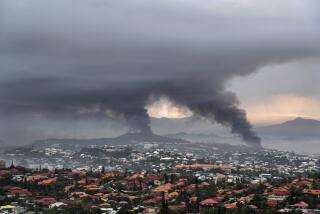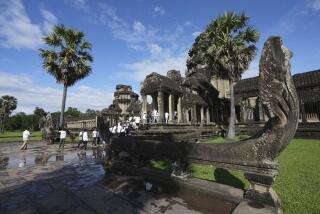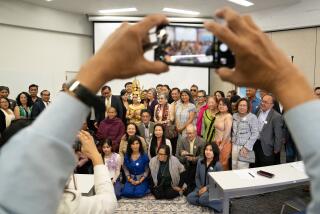Cambodia Lawmakers Take Office as Tensions Persist
- Share via
SIEM REAP, Cambodia — With the towers of Angkor Wat serving as reminders of Cambodia’s past greatness, the feuding leaders of this troubled nation have come here in search of an elusive peace.
The swearing-in today of the new National Assembly on the steps of Cambodia’s most sacred temples marks the tentative first move by the country’s political foes toward reconciliation after nearly two months of postelection violence.
Thousands of demonstrators had spilled into the streets of the capital, Phnom Penh, to protest the July 26 elections that kept strongman Hun Sen and the ruling Cambodian People’s Party in power. The violent clashes between police and government supporters finally ended a week ago after opposition followers heeded their leaders’ pleas to avoid further bloodshed.
Yet even this morning, as assembly members traveled to the swearing-in ceremony, a booby-trapped rocket-propelled grenade exploded on their route, not far from Hun Sen’s convoy. No legislators were harmed, but four people--including two children--were killed, police said.
On Tuesday, rival leaders of the Cambodian People’s Party and the two main opposition parties--the royalist FUNCINPEC party and the Sam Rainsy Party--met for the first time since Hun Sen overthrew his co-premier, Prince Norodom Ranariddh of the royalist party, in a bloody coup in July 1997.
Yet the cordiality of the moment belies tensions that longtime observers fear could easily degenerate into chaos. At this point, there is no agreement on the formation of a new government, with Hun Sen’s party short of a two-thirds majority in the assembly.
Even if a three-way coalition government can be formed in the coming weeks, both Cambodian and Western analysts are skeptical that the lasting peace and prosperity that people so desperately desire are within easy reach.
“An agreement doesn’t mean that a coalition government can work. It might collapse again,” said Kao Kim Hourn, director of the Cambodia Institute for Cooperation and Peace. “It’s really a cycle of power struggles that leaves us nowhere.”
Indeed, there are echoes today of the 1993 U.N.-brokered elections that sought to bring democracy to a nation long torn apart by genocide, warfare and political fighting. Ranariddh won that time but was forced into a power-sharing arrangement with Hun Sen, who had threatened a civil war.
Their uneasy partnership ended when Hun Sen’s coup toppled Ranariddh and terrorized Phnom Penh. About 100 of the prince’s supporters were killed.
Since then, Cambodia has faced steady international pressure. Its U.N. seat has been declared vacant; funding from the World Bank and International Monetary Fund has ceased; and membership in the Assn. of Southeast Asian Nations is on hold. Foreign investment has disappeared, and tourism has died.
So the general elections in July represented what could be the nation’s last chance to salvage its image on the world stage and show that it could carry off a democratic process.
And at first, it seemed that all was well. More than 90% of the country’s 5.4 million voters turned out to polling stations. An international team of European and U.S. monitors promptly pronounced the voting “free and fair.”
Hun Sen’s party captured about half the 122 seats in the assembly. Opposition opponents immediately cried foul, claiming electoral fraud and systematic intimidation.
Human rights activists agree, pointing out that the electoral process, from the media to the election committees, is controlled by Hun Sen’s party.
“People out in the villages kept asking me to explain how the international community could call these free and fair,” one human rights worker said. “They expected that foreigners would make sure there was a chance for true change. That didn’t happen, and they’re very angry and disappointed about that.”
The opposition’s appeals to the National Election Committee and the Constitutional Council, both filled with Hun Sen supporters, were summarily rejected.
Opposition supporters promptly took to the streets in one of the most spontaneous acts of political expression seen here. Riding on motorbikes and bicycles, thousands of people filled the wide avenues of the capital.
From balconies and storefronts, regular citizens joined in, giving demonstrators food and cheering in support. Protesters, including monks, students and supporters of Ranariddh and Rainsy, demanded Hun Sen’s ouster.
Analysts consider the public outcry a turning point in Cambodians’ understanding of their role in politics.
“It’s new in our history--the first time we’ve ever had a large-scale and mainly peaceful and orderly protest,” said Lao Mong Hay, head of the Khmer Institute of Democracy think tank. “Cambodians have understood the lessons of democracy, and they’re beginning to demand their rights.”
Washington-based Cambodia expert Paul Grove concurred, saying, “The demonstrations encompass more than the elections; they are an indication that a boiling point has been reached with the heavy-handed, often-lawless leadership of the CPP.”
But within a week of the protests, the government cracked down with police firing on demonstrators and attacking with gun butts, riot batons and cattle prods.
Four demonstrators were confirmed killed. Human rights groups have documented an additional 18 bodies that have washed up from the river or were buried in shallow graves, bound and bullet-ridden.
That violence, and this morning’s incident, served as sobering reminders that guns and brute strength have been the law of the land for decades.
Both Ranariddh and Rainsy urged a halt to the protests and agreed to a meeting of the rival parties.
More to Read
Sign up for Essential California
The most important California stories and recommendations in your inbox every morning.
You may occasionally receive promotional content from the Los Angeles Times.










